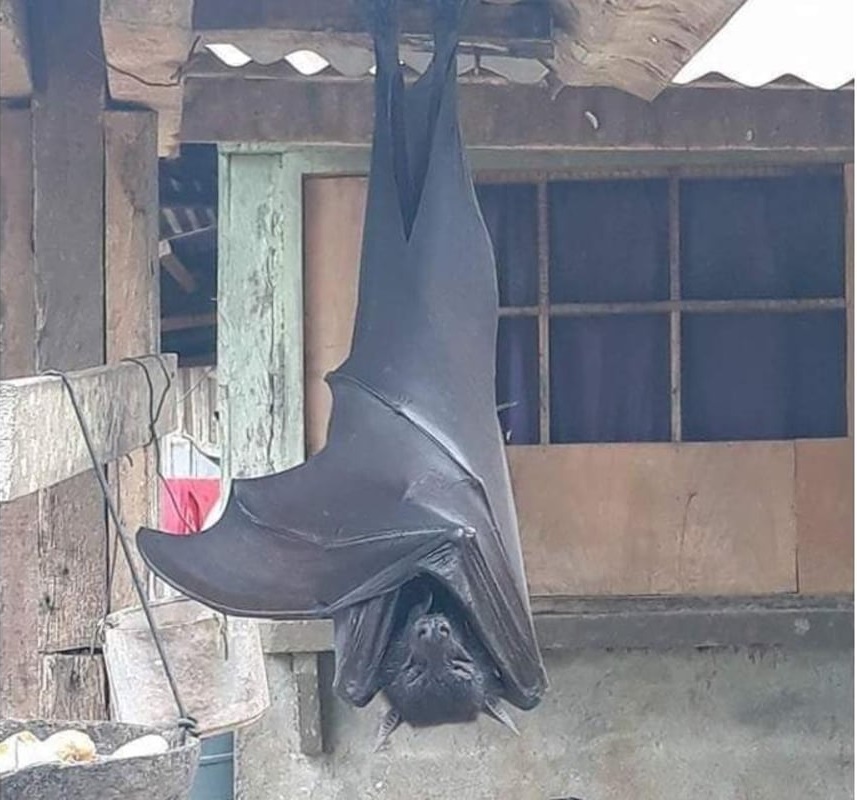
Meet The Biggest Bat In The World, The Golden-Crowned Flying Fox
Unfortunately, the continuous encroachment upon the animal’s habitat has seen it virtually disappear. To be clear, one can still find the giant golden-crowned flying fox all over the Philippines — but only in areas that are peaceful enough for it to let its guard down.
The Biggest Bat In The World Is Endangered
The destruction of its habitat and profit-driven hunting have seen the giant golden-crowned flying fox become an endangered species. The dwindling numbers in recent years are a clear sign that its very survival is being threatened.
More than 90 percent of the old-growth forests of the Philippines have been destroyed, forcing the species to abandon its natural roosting sites across multiple islands. On top of that, local communities hunt the bats — not merely for profit and sale, but for recreational and sporting reasons too.Fortunately, there are several non-profit organizations whose entire mission is to curb that problem. Bat Conservation International, for instance, works in tandem with two Filipino non-governmental organizations (NGOs) that have direct access to national and local government units that help out.
On the ground, some local communities protect roosting sites directly, while others work on educating their countrymen and women on the importance of helping this species survive. However, these enormous bats do pose one potential threat.Though these bats are generally harmless, it is possible for them to carry and transmit diseases to humans. However, if left alone, it’s highly unlikely that bat-to-human infection would occur.
Threats And Conservation Of The Giant Golden-Crowned Flying Fox
The International Union for Conservation of Nature (IUCN) listed the giant golden-crowned flying fox as endangered in 2016 after the animal’s population declined by a whopping 50 percent from 1986 to 2016.
Sadly, hunting it for bushmeat continues to drive the golden-crowned flying fox population down. Even more troubling, the hunting practice itself is rather ineffective. Hunters shoot these animals out of their roosts, wounding more of them than necessary, as many who are killed don’t even fall from the trees.As such, a poacher might kill up to 30 bats merely to recover 10. While terribly inhumane, poverty and desperation for food drive this practice. Deforestation, meanwhile, has seen the animal virtually disappear from the islands of Panay and Cebu.
While the species is protected by the 2001 Philippine Wildlife Resources Conservation and Protection Act, this law isn’t too stringently enforced. As such, the fact that the majority of the animal’s roosts are inside of protected areas doesn’t matter — as illegal hunting simply continues as usual.Ultimately, there are a few captive breeding programs that regionally attempt to maintain the species’ population. Whether or not these will suffice to keep the giant golden-crowned flying fox around for much longer is unclear, as the two primary causes of its endangerment continue uninterrupted.
After learning about the giant golden-crowned flying fox, the largest bat in the world, read about the Asian giant hornet, the bee-decapitating hornet that is the stuff of nightmares. Then, watch this stunning footage of the world’s largest animal eating.
The Biggest Bat In The World Is Endangered
The destruction of its habitat and profit-driven hunting have seen the giant golden-crowned flying fox become an endangered species. The dwindling numbers in recent years are a clear sign that its very survival is being threatened.
More than 90 percent of the old-growth forests of the Philippines have been destroyed, forcing the species to abandon its natural roosting sites across multiple islands. On top of that, local communities hunt the bats — not merely for profit and sale, but for recreational and sporting reasons too.Fortunately, there are several non-profit organizations whose entire mission is to curb that problem. Bat Conservation International, for instance, works in tandem with two Filipino non-governmental organizations (NGOs) that have direct access to national and local government units that help out.
On the ground, some local communities protect roosting sites directly, while others work on educating their countrymen and women on the importance of helping this species survive. However, these enormous bats do pose one potential threat.Though these bats are generally harmless, it is possible for them to carry and transmit diseases to humans. However, if left alone, it’s highly unlikely that bat-to-human infection would occur.
Threats And Conservation Of The Giant Golden-Crowned Flying Fox
The International Union for Conservation of Nature (IUCN) listed the giant golden-crowned flying fox as endangered in 2016 after the animal’s population declined by a whopping 50 percent from 1986 to 2016.
Sadly, hunting it for bushmeat continues to drive the golden-crowned flying fox population down. Even more troubling, the hunting practice itself is rather ineffective. Hunters shoot these animals out of their roosts, wounding more of them than necessary, as many who are killed don’t even fall from the trees.As such, a poacher might kill up to 30 bats merely to recover 10. While terribly inhumane, poverty and desperation for food drive this practice. Deforestation, meanwhile, has seen the animal virtually disappear from the islands of Panay and Cebu.
While the species is protected by the 2001 Philippine Wildlife Resources Conservation and Protection Act, this law isn’t too stringently enforced. As such, the fact that the majority of the animal’s roosts are inside of protected areas doesn’t matter — as illegal hunting simply continues as usual.Ultimately, there are a few captive breeding programs that regionally attempt to maintain the species’ population. Whether or not these will suffice to keep the giant golden-crowned flying fox around for much longer is unclear, as the two primary causes of its endangerment continue uninterrupted.
After learning about the giant golden-crowned flying fox, the largest bat in the world, read about the Asian giant hornet, the bee-decapitating hornet that is the stuff of nightmares. Then, watch this stunning footage of the world’s largest animal eating.
Advertisements
22 February 2023
Advertisements



